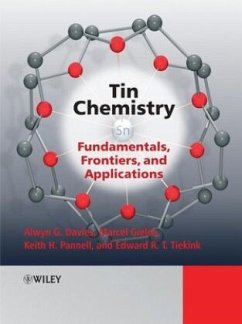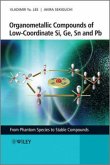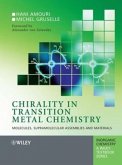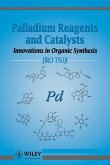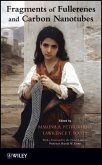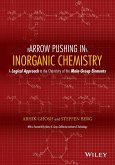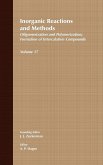Marcel GielenFundamentals, Frontiers, and Applications
Tin Chemistry
Fundamentals, Frontiers, and Applications
Herausgegeben:Davies, Alwyn G.; Pannell, Keith; Tiekink, Edward
Marcel GielenFundamentals, Frontiers, and Applications
Tin Chemistry
Fundamentals, Frontiers, and Applications
Herausgegeben:Davies, Alwyn G.; Pannell, Keith; Tiekink, Edward
- Gebundenes Buch
- Merkliste
- Auf die Merkliste
- Bewerten Bewerten
- Teilen
- Produkt teilen
- Produkterinnerung
- Produkterinnerung
New and exciting research on tin is being generated on an annual basis from all parts of the world. Tin Chemistry collects, in one comprehensive volume, authoritative and concise snapshots of modern tin chemistry in a full range of applications. Over forty of the leading tin chemistry experts have contributed reviews on the applications as well as fundamentals of modern tin chemistry. The book provides an essential overview of modern perspectives on this important element for academic and industrial researchers, postgraduates, and final-year undergraduate students.
_ First authoritative…mehr
Andere Kunden interessierten sich auch für
![Organometallic Compounds of Low-Coordinate Si, Ge, Sn and PB Organometallic Compounds of Low-Coordinate Si, Ge, Sn and PB]() Vladimir Ya. LeeOrganometallic Compounds of Low-Coordinate Si, Ge, Sn and PB187,99 €
Vladimir Ya. LeeOrganometallic Compounds of Low-Coordinate Si, Ge, Sn and PB187,99 €![Chirality in Transition Metal Chemistry Chirality in Transition Metal Chemistry]() Hani AmouriChirality in Transition Metal Chemistry214,99 €
Hani AmouriChirality in Transition Metal Chemistry214,99 €![Palladium Reagents and Catalysts Palladium Reagents and Catalysts]() Jiro TsujiPalladium Reagents and Catalysts301,99 €
Jiro TsujiPalladium Reagents and Catalysts301,99 €![Fragments of Fullerenes and Carbon Nanotubes Fragments of Fullerenes and Carbon Nanotubes]() Fragments of Fullerenes and Carbon Nanotubes160,99 €
Fragments of Fullerenes and Carbon Nanotubes160,99 €![Arrow Pushing in Inorganic Chemistry Arrow Pushing in Inorganic Chemistry]() Abhik GhoshArrow Pushing in Inorganic Chemistry79,99 €
Abhik GhoshArrow Pushing in Inorganic Chemistry79,99 €![Inorganic Reactions and Methods, Oligomerization and Polymerization Formation of Intercalation Compounds Inorganic Reactions and Methods, Oligomerization and Polymerization Formation of Intercalation Compounds]() J. J. Zuckerman / A. P. Hagen (Hgg.)Inorganic Reactions and Methods, Oligomerization and Polymerization Formation of Intercalation Compounds620,99 €
J. J. Zuckerman / A. P. Hagen (Hgg.)Inorganic Reactions and Methods, Oligomerization and Polymerization Formation of Intercalation Compounds620,99 €![Inorganic Reactions and Methods, the Formation of the Bond to Hydrogen (Part 2) Inorganic Reactions and Methods, the Formation of the Bond to Hydrogen (Part 2)]() J. J. Zuckerman (Hrsg.)Inorganic Reactions and Methods, the Formation of the Bond to Hydrogen (Part 2)617,99 €
J. J. Zuckerman (Hrsg.)Inorganic Reactions and Methods, the Formation of the Bond to Hydrogen (Part 2)617,99 €-
-
-
New and exciting research on tin is being generated on an annual basis from all parts of the world. Tin Chemistry collects, in one comprehensive volume, authoritative and concise snapshots of modern tin chemistry in a full range of applications. Over forty of the leading tin chemistry experts have contributed reviews on the applications as well as fundamentals of modern tin chemistry. The book provides an essential overview of modern perspectives on this important element for academic and industrial researchers, postgraduates, and final-year undergraduate students.
_ First authoritative one-volume survey of all aspects of modern tin chemistry, appropriate for the specialist and non-specialist alike.
_ Contains 40 chapters from leading researchers, describing the applications as well as fundamentals
_ Introductory chapter links together the six main themes: fundamentals in tin chemistry; materials and structural chemistry; medicinal and biocidal applications; tin the environment; tin in organic synthesis ; tin in catalysis
_ Wide-ranging survey will promote cross-disciplinary interactions
_ Essential teaching resource for advanced university classes.
Hinweis: Dieser Artikel kann nur an eine deutsche Lieferadresse ausgeliefert werden.
_ First authoritative one-volume survey of all aspects of modern tin chemistry, appropriate for the specialist and non-specialist alike.
_ Contains 40 chapters from leading researchers, describing the applications as well as fundamentals
_ Introductory chapter links together the six main themes: fundamentals in tin chemistry; materials and structural chemistry; medicinal and biocidal applications; tin the environment; tin in organic synthesis ; tin in catalysis
_ Wide-ranging survey will promote cross-disciplinary interactions
_ Essential teaching resource for advanced university classes.
Hinweis: Dieser Artikel kann nur an eine deutsche Lieferadresse ausgeliefert werden.
Produktdetails
- Produktdetails
- Verlag: Wiley & Sons
- 1. Auflage
- Seitenzahl: 752
- Erscheinungstermin: 13. Oktober 2008
- Englisch
- Abmessung: 256mm x 197mm x 52mm
- Gewicht: 1790g
- ISBN-13: 9780470517710
- ISBN-10: 0470517719
- Artikelnr.: 23594290
- Herstellerkennzeichnung
- Libri GmbH
- Europaallee 1
- 36244 Bad Hersfeld
- gpsr@libri.de
- Verlag: Wiley & Sons
- 1. Auflage
- Seitenzahl: 752
- Erscheinungstermin: 13. Oktober 2008
- Englisch
- Abmessung: 256mm x 197mm x 52mm
- Gewicht: 1790g
- ISBN-13: 9780470517710
- ISBN-10: 0470517719
- Artikelnr.: 23594290
- Herstellerkennzeichnung
- Libri GmbH
- Europaallee 1
- 36244 Bad Hersfeld
- gpsr@libri.de
Professor Alwyn Davies, FRS, University College London, UK Professor Davies is the author of Organotin Chemistry (Wiley-VCH, 2nd Edition 2004) and editor-in-chief of Journal of Chemical Research and Science Reviews. Professor Marcel Gielen, Vrije Universiteit Brussel, Belgium Professor Gielen is the author of several organometallic books and editor of the journals Main Group Metal Chemistry and Applied Organometallic Chemistry. Professor Keith Pannell, University of Texas at El Paso, USA Professor Pannell has published over 200 articles in the international literature in the general area of main group chemistry. Professor Edward Tiekink, University of Texas at San Antonio, USA Professor Tiekink serves as co/associate editor for Acta Crystallographica E, Applied Organometallic Chemistry, Bioinorganic Chemistry & Applications , and Zeitschrift fur Kristallographie.
1. Introduction and overview (A. G. Davies).
2. Fundamentals in tin chemistry.
2.1 NMR of tin compounds (Bernd Wrackmeyer).
2.2 Sn(II) clusters (Tris Chivers and Dana Eisler).
2.3 Monorganotin oxo-clusters (François Ribot).
2.4 Organotin carboxylate and -sulfonate clusters (Vadapalli Chand
Rasekhar).
2.5 Macrocyclic and supramolecular chemistry of organotin compounds
(Herbert Höpfl).
2.6 Tin Zintl Ions: Synthesis, Structures, and Reactivity (Slavi Sevov).
2.7 Stable stannyl cations in condensed phase (Joe Lambert).
2.8 Preparation and coordination chemistry of mono- and bidentate
stannylenes (Alexander V. Zabula and F. Ekkehardt Hahn).
2.9 Stannenes, distannenes and stannynes (Norihiro Tokitoh and Yoshiyuki
Mizuhata).
2.10 Distannoxanes (Klaus Jurkschat).
2.11 Unusual bonds and coordination geometries (Raymundo Cea-Olivares).
2.12 Tin(II) heterobimetallic and oligometallic derivatives (Muhammad
Mazhar).
2.13 Computational Methods for Organotin Compounds (Sarah Whittleton,
Russell J. Boyd, and T. Bruce Grindley).
3. Materials Chemistry and Structural Chemistry of tin compounds.
3.1 Tin compounds for CVD (Geraldo Lima).
3.2 Class II Tin-Based Hybrid Materials Prepared From Alkynyltin Precursors
(Thierry Toupance).
3.3 Organotin compounds as PVC stabilizers (Esen Arkis).
3.4 Organotin compounds as anion-selective carriers in chemical sensors
(Nikos Chaniotakis).
3.5 Tin compounds as flame retardants and smoke suppressants (Paul Cusack).
3.6 Quadratic nonlinear optical properties in tin-based compounds (Pascal
G. Lacroix).
3.7 Tin-based hybrid materials (Bernard Jousseaume).
3.8 Organotin polymers and related materials (Keith Pannell and Sharma).
3.9 Intermolecular tin...¿-aryl interactions: fact or artifact*?
A new bonding motif for supramolecular self-assembly in organotin compounds
(Ionel Haiduc, Edward Tiekink and Julio Zukerman-Schpector).
4. Medicinal/Biocidal Applications of tin compounds and Environmental
Aspects.
4.1 The cardiovascular activity of organotin compounds (Mala Nath).
4.2 Organotins: Insecticidal and larvicidal activity (George Eng and
Xueqing Song).
4.3 Antifungal activity of organotin compounds (Heloisa Beraldo and Geraldo
M. de Lima).
4.4 Chemical and biotechnological developments in organotin cancer
chemotherapy (Claudio Pettinariÿ and Fabio Marchetti).
4.5 Impact of organotin compounds on the function of human natural killer
cells (Margaret M. Whalen).
4.6 Biological aspects of organotins: perspective in structural and
molecular biology (Norberto Farfán, Hiram Beltran and Rosa Santillan).
5. Tin in Organic Synthesis.
5.1 Applications of Organotin Derivatives for Carbohydrate Synthesis (T.
Bruce Grindley).
5.2 Reactions of SE? Substitution for Organostannanes in Organic Synthesis
(David R. Williams and Partha P. Nag).
5.3 Organotin compounds for Carbon-Carbon Cross-Coupling (Pablo Espinet and
Miroslav Genov).
5.4 Cross-Coupling of Organotin compounds for Carbon-Carbon Bond Formation:
Applications in Total Synthesis (Antonio Echavarren).
5.5 New Trends in the Synthesis of Solid-Supported Organotin Reagents and
Interest of their Use in Organic Synthesis in a Concept of Green Chemistry
(Jean-Mathieu Chrétien, Jeremy D. Kilburn, Françoise Zammattio, Erwan Le
Grognec and Jean-Paul Quintard).
5.6 Palladium Catalysed Cascade Cyclisation-Anion Capture Processes
Employing Pre- and In Situ-Formed Organostannanes (Ronald Grigg and V.
Sridharan).
5.7 Carbostannylations of carbon-carbon unsaturated bonds (Eiji Shirakawa).
5.8 Green Organostannane Chemistry: an Oxymoron (David Young)?
6. Tin in Catalysis.
6.1 Green organotin catalysts (Junzo Otera, Monique Biesemans, Vanja
Pinoie, Kevin Poelmans and Rudolph Willem).
6.2 Organotin catalysts for isocyanate reactions (Werner J. Blank and
Edward T. Hessell).
6.3 Catalysis of reactions of allyltin compounds and organotin phenoxides
by lithium perchlorate (Wojciech J. Kinart and Cezary M. Kinart).
2. Fundamentals in tin chemistry.
2.1 NMR of tin compounds (Bernd Wrackmeyer).
2.2 Sn(II) clusters (Tris Chivers and Dana Eisler).
2.3 Monorganotin oxo-clusters (François Ribot).
2.4 Organotin carboxylate and -sulfonate clusters (Vadapalli Chand
Rasekhar).
2.5 Macrocyclic and supramolecular chemistry of organotin compounds
(Herbert Höpfl).
2.6 Tin Zintl Ions: Synthesis, Structures, and Reactivity (Slavi Sevov).
2.7 Stable stannyl cations in condensed phase (Joe Lambert).
2.8 Preparation and coordination chemistry of mono- and bidentate
stannylenes (Alexander V. Zabula and F. Ekkehardt Hahn).
2.9 Stannenes, distannenes and stannynes (Norihiro Tokitoh and Yoshiyuki
Mizuhata).
2.10 Distannoxanes (Klaus Jurkschat).
2.11 Unusual bonds and coordination geometries (Raymundo Cea-Olivares).
2.12 Tin(II) heterobimetallic and oligometallic derivatives (Muhammad
Mazhar).
2.13 Computational Methods for Organotin Compounds (Sarah Whittleton,
Russell J. Boyd, and T. Bruce Grindley).
3. Materials Chemistry and Structural Chemistry of tin compounds.
3.1 Tin compounds for CVD (Geraldo Lima).
3.2 Class II Tin-Based Hybrid Materials Prepared From Alkynyltin Precursors
(Thierry Toupance).
3.3 Organotin compounds as PVC stabilizers (Esen Arkis).
3.4 Organotin compounds as anion-selective carriers in chemical sensors
(Nikos Chaniotakis).
3.5 Tin compounds as flame retardants and smoke suppressants (Paul Cusack).
3.6 Quadratic nonlinear optical properties in tin-based compounds (Pascal
G. Lacroix).
3.7 Tin-based hybrid materials (Bernard Jousseaume).
3.8 Organotin polymers and related materials (Keith Pannell and Sharma).
3.9 Intermolecular tin...¿-aryl interactions: fact or artifact*?
A new bonding motif for supramolecular self-assembly in organotin compounds
(Ionel Haiduc, Edward Tiekink and Julio Zukerman-Schpector).
4. Medicinal/Biocidal Applications of tin compounds and Environmental
Aspects.
4.1 The cardiovascular activity of organotin compounds (Mala Nath).
4.2 Organotins: Insecticidal and larvicidal activity (George Eng and
Xueqing Song).
4.3 Antifungal activity of organotin compounds (Heloisa Beraldo and Geraldo
M. de Lima).
4.4 Chemical and biotechnological developments in organotin cancer
chemotherapy (Claudio Pettinariÿ and Fabio Marchetti).
4.5 Impact of organotin compounds on the function of human natural killer
cells (Margaret M. Whalen).
4.6 Biological aspects of organotins: perspective in structural and
molecular biology (Norberto Farfán, Hiram Beltran and Rosa Santillan).
5. Tin in Organic Synthesis.
5.1 Applications of Organotin Derivatives for Carbohydrate Synthesis (T.
Bruce Grindley).
5.2 Reactions of SE? Substitution for Organostannanes in Organic Synthesis
(David R. Williams and Partha P. Nag).
5.3 Organotin compounds for Carbon-Carbon Cross-Coupling (Pablo Espinet and
Miroslav Genov).
5.4 Cross-Coupling of Organotin compounds for Carbon-Carbon Bond Formation:
Applications in Total Synthesis (Antonio Echavarren).
5.5 New Trends in the Synthesis of Solid-Supported Organotin Reagents and
Interest of their Use in Organic Synthesis in a Concept of Green Chemistry
(Jean-Mathieu Chrétien, Jeremy D. Kilburn, Françoise Zammattio, Erwan Le
Grognec and Jean-Paul Quintard).
5.6 Palladium Catalysed Cascade Cyclisation-Anion Capture Processes
Employing Pre- and In Situ-Formed Organostannanes (Ronald Grigg and V.
Sridharan).
5.7 Carbostannylations of carbon-carbon unsaturated bonds (Eiji Shirakawa).
5.8 Green Organostannane Chemistry: an Oxymoron (David Young)?
6. Tin in Catalysis.
6.1 Green organotin catalysts (Junzo Otera, Monique Biesemans, Vanja
Pinoie, Kevin Poelmans and Rudolph Willem).
6.2 Organotin catalysts for isocyanate reactions (Werner J. Blank and
Edward T. Hessell).
6.3 Catalysis of reactions of allyltin compounds and organotin phenoxides
by lithium perchlorate (Wojciech J. Kinart and Cezary M. Kinart).
1. Introduction and overview (A. G. Davies).
2. Fundamentals in tin chemistry.
2.1 NMR of tin compounds (Bernd Wrackmeyer).
2.2 Sn(II) clusters (Tris Chivers and Dana Eisler).
2.3 Monorganotin oxo-clusters (François Ribot).
2.4 Organotin carboxylate and -sulfonate clusters (Vadapalli Chand
Rasekhar).
2.5 Macrocyclic and supramolecular chemistry of organotin compounds
(Herbert Höpfl).
2.6 Tin Zintl Ions: Synthesis, Structures, and Reactivity (Slavi Sevov).
2.7 Stable stannyl cations in condensed phase (Joe Lambert).
2.8 Preparation and coordination chemistry of mono- and bidentate
stannylenes (Alexander V. Zabula and F. Ekkehardt Hahn).
2.9 Stannenes, distannenes and stannynes (Norihiro Tokitoh and Yoshiyuki
Mizuhata).
2.10 Distannoxanes (Klaus Jurkschat).
2.11 Unusual bonds and coordination geometries (Raymundo Cea-Olivares).
2.12 Tin(II) heterobimetallic and oligometallic derivatives (Muhammad
Mazhar).
2.13 Computational Methods for Organotin Compounds (Sarah Whittleton,
Russell J. Boyd, and T. Bruce Grindley).
3. Materials Chemistry and Structural Chemistry of tin compounds.
3.1 Tin compounds for CVD (Geraldo Lima).
3.2 Class II Tin-Based Hybrid Materials Prepared From Alkynyltin Precursors
(Thierry Toupance).
3.3 Organotin compounds as PVC stabilizers (Esen Arkis).
3.4 Organotin compounds as anion-selective carriers in chemical sensors
(Nikos Chaniotakis).
3.5 Tin compounds as flame retardants and smoke suppressants (Paul Cusack).
3.6 Quadratic nonlinear optical properties in tin-based compounds (Pascal
G. Lacroix).
3.7 Tin-based hybrid materials (Bernard Jousseaume).
3.8 Organotin polymers and related materials (Keith Pannell and Sharma).
3.9 Intermolecular tin...¿-aryl interactions: fact or artifact*?
A new bonding motif for supramolecular self-assembly in organotin compounds
(Ionel Haiduc, Edward Tiekink and Julio Zukerman-Schpector).
4. Medicinal/Biocidal Applications of tin compounds and Environmental
Aspects.
4.1 The cardiovascular activity of organotin compounds (Mala Nath).
4.2 Organotins: Insecticidal and larvicidal activity (George Eng and
Xueqing Song).
4.3 Antifungal activity of organotin compounds (Heloisa Beraldo and Geraldo
M. de Lima).
4.4 Chemical and biotechnological developments in organotin cancer
chemotherapy (Claudio Pettinariÿ and Fabio Marchetti).
4.5 Impact of organotin compounds on the function of human natural killer
cells (Margaret M. Whalen).
4.6 Biological aspects of organotins: perspective in structural and
molecular biology (Norberto Farfán, Hiram Beltran and Rosa Santillan).
5. Tin in Organic Synthesis.
5.1 Applications of Organotin Derivatives for Carbohydrate Synthesis (T.
Bruce Grindley).
5.2 Reactions of SE? Substitution for Organostannanes in Organic Synthesis
(David R. Williams and Partha P. Nag).
5.3 Organotin compounds for Carbon-Carbon Cross-Coupling (Pablo Espinet and
Miroslav Genov).
5.4 Cross-Coupling of Organotin compounds for Carbon-Carbon Bond Formation:
Applications in Total Synthesis (Antonio Echavarren).
5.5 New Trends in the Synthesis of Solid-Supported Organotin Reagents and
Interest of their Use in Organic Synthesis in a Concept of Green Chemistry
(Jean-Mathieu Chrétien, Jeremy D. Kilburn, Françoise Zammattio, Erwan Le
Grognec and Jean-Paul Quintard).
5.6 Palladium Catalysed Cascade Cyclisation-Anion Capture Processes
Employing Pre- and In Situ-Formed Organostannanes (Ronald Grigg and V.
Sridharan).
5.7 Carbostannylations of carbon-carbon unsaturated bonds (Eiji Shirakawa).
5.8 Green Organostannane Chemistry: an Oxymoron (David Young)?
6. Tin in Catalysis.
6.1 Green organotin catalysts (Junzo Otera, Monique Biesemans, Vanja
Pinoie, Kevin Poelmans and Rudolph Willem).
6.2 Organotin catalysts for isocyanate reactions (Werner J. Blank and
Edward T. Hessell).
6.3 Catalysis of reactions of allyltin compounds and organotin phenoxides
by lithium perchlorate (Wojciech J. Kinart and Cezary M. Kinart).
2. Fundamentals in tin chemistry.
2.1 NMR of tin compounds (Bernd Wrackmeyer).
2.2 Sn(II) clusters (Tris Chivers and Dana Eisler).
2.3 Monorganotin oxo-clusters (François Ribot).
2.4 Organotin carboxylate and -sulfonate clusters (Vadapalli Chand
Rasekhar).
2.5 Macrocyclic and supramolecular chemistry of organotin compounds
(Herbert Höpfl).
2.6 Tin Zintl Ions: Synthesis, Structures, and Reactivity (Slavi Sevov).
2.7 Stable stannyl cations in condensed phase (Joe Lambert).
2.8 Preparation and coordination chemistry of mono- and bidentate
stannylenes (Alexander V. Zabula and F. Ekkehardt Hahn).
2.9 Stannenes, distannenes and stannynes (Norihiro Tokitoh and Yoshiyuki
Mizuhata).
2.10 Distannoxanes (Klaus Jurkschat).
2.11 Unusual bonds and coordination geometries (Raymundo Cea-Olivares).
2.12 Tin(II) heterobimetallic and oligometallic derivatives (Muhammad
Mazhar).
2.13 Computational Methods for Organotin Compounds (Sarah Whittleton,
Russell J. Boyd, and T. Bruce Grindley).
3. Materials Chemistry and Structural Chemistry of tin compounds.
3.1 Tin compounds for CVD (Geraldo Lima).
3.2 Class II Tin-Based Hybrid Materials Prepared From Alkynyltin Precursors
(Thierry Toupance).
3.3 Organotin compounds as PVC stabilizers (Esen Arkis).
3.4 Organotin compounds as anion-selective carriers in chemical sensors
(Nikos Chaniotakis).
3.5 Tin compounds as flame retardants and smoke suppressants (Paul Cusack).
3.6 Quadratic nonlinear optical properties in tin-based compounds (Pascal
G. Lacroix).
3.7 Tin-based hybrid materials (Bernard Jousseaume).
3.8 Organotin polymers and related materials (Keith Pannell and Sharma).
3.9 Intermolecular tin...¿-aryl interactions: fact or artifact*?
A new bonding motif for supramolecular self-assembly in organotin compounds
(Ionel Haiduc, Edward Tiekink and Julio Zukerman-Schpector).
4. Medicinal/Biocidal Applications of tin compounds and Environmental
Aspects.
4.1 The cardiovascular activity of organotin compounds (Mala Nath).
4.2 Organotins: Insecticidal and larvicidal activity (George Eng and
Xueqing Song).
4.3 Antifungal activity of organotin compounds (Heloisa Beraldo and Geraldo
M. de Lima).
4.4 Chemical and biotechnological developments in organotin cancer
chemotherapy (Claudio Pettinariÿ and Fabio Marchetti).
4.5 Impact of organotin compounds on the function of human natural killer
cells (Margaret M. Whalen).
4.6 Biological aspects of organotins: perspective in structural and
molecular biology (Norberto Farfán, Hiram Beltran and Rosa Santillan).
5. Tin in Organic Synthesis.
5.1 Applications of Organotin Derivatives for Carbohydrate Synthesis (T.
Bruce Grindley).
5.2 Reactions of SE? Substitution for Organostannanes in Organic Synthesis
(David R. Williams and Partha P. Nag).
5.3 Organotin compounds for Carbon-Carbon Cross-Coupling (Pablo Espinet and
Miroslav Genov).
5.4 Cross-Coupling of Organotin compounds for Carbon-Carbon Bond Formation:
Applications in Total Synthesis (Antonio Echavarren).
5.5 New Trends in the Synthesis of Solid-Supported Organotin Reagents and
Interest of their Use in Organic Synthesis in a Concept of Green Chemistry
(Jean-Mathieu Chrétien, Jeremy D. Kilburn, Françoise Zammattio, Erwan Le
Grognec and Jean-Paul Quintard).
5.6 Palladium Catalysed Cascade Cyclisation-Anion Capture Processes
Employing Pre- and In Situ-Formed Organostannanes (Ronald Grigg and V.
Sridharan).
5.7 Carbostannylations of carbon-carbon unsaturated bonds (Eiji Shirakawa).
5.8 Green Organostannane Chemistry: an Oxymoron (David Young)?
6. Tin in Catalysis.
6.1 Green organotin catalysts (Junzo Otera, Monique Biesemans, Vanja
Pinoie, Kevin Poelmans and Rudolph Willem).
6.2 Organotin catalysts for isocyanate reactions (Werner J. Blank and
Edward T. Hessell).
6.3 Catalysis of reactions of allyltin compounds and organotin phenoxides
by lithium perchlorate (Wojciech J. Kinart and Cezary M. Kinart).

